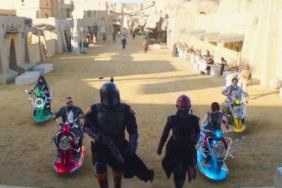J. W. Rinzler discusses his various books, including last year’s The Making of Star Wars and The Complete Making of Indiana Jones.
Crave Online: Could you talk about what it was like going through the Lucasfilm Archives? You’ve done that for multiple books.
Rinzler: Really the last two. The first book [I wrote concerning] Episode III, was on the set. I had done research for other books that I’ve edited, though. For [Creating the Worlds of Star Wars] John [Knoll] actually did most of the archive stuff. We had some fun arranging stuff in the actual archives for his photos: moving the Death Star around [laughs]. We wheeled it, [and] a few vehicles like the star destroyer, around to create a good photo. That was fun. Also, the Cinema of George Lucas, [involved] archives.
So basically over the years, through trial-and-error, and tips, and so on, I figured out where a lot of the stuff is. In addition to the central Archive, there are also other places where you’ll find a lot of good stuff.
Crave Online: I imagine there would be paperwork like Lucas’s handwritten notes, and there are movie artifacts, and concept art…
Rinzler: Right, and they’re all in different places. Lucas’s handwritten stuff is pretty special, so that’s in one place. And the props and matte paintings are in the central archival places, which are also the sources of camera footage—in the film archives. But then there are also other places where there are just boxes of production notes, which were basically just thrown into crates. They were either moved, or somebody left the company after 20 years, or whatever. Those are kind of frightening to go through, but you have to because every hundred documents or so, you find something really interesting.
. . . I’ve seen the soft underbelly of it, the tedium that goes into making these movies [laughs]. Even when you’re there on set, you sit there, and after the excitement wears off after about the first hour, you’re just there for 12 hours a day! [Laughs] But then every day there are very, very interesting moments.
Crave Online: I imagine you’re talking about when you were on the set of Revenge of the Sith [preparing the book The Making of Star Wars: Revenge of the Sith]?
Rinzler: Yeah.
Crave Online: When I was reading The Making of Star Wars I was thinking that, as long as the book is, there were probably a lot of things that you would have liked to include but there wasn’t room for everything.
Rinzler: Obviously, we had to leave some things out. Most of the stuff we left out, though, were just photos. There was nothing key that we left out. There was just so much, particularly the black-and-white photos, that had never been published before and some color photos of behind-the-scenes from the cantina pickups. We just couldn’t fit all those in.
Crave Online: One thing I was curious about regarding the production notes: in the first week of studio filming in England, there’s mention of shooting the Anchorhead power station interior on stage 7. Was there anything eventful documented about that?
Rinzler: There were production notes for everything and progress reports but [in this case] nothing except that they shot it.
Crave Online: Did you see any drawings of that set by John Barry?
Rinzler: I don’t recall coming across any, but I now have my head completely in Empire Strikes Back now.
Crave Online: Oh, are you writing a similar book about “Empire” now?
Rinzler: Yeah.
Crave Online: And hopefully you’ll do one “Jedi” eventually?
Rinzler: Who knows? [Laughs.]
Crave Online: I’ve always wondered about that computerized game in the Anchorhead power station. In the script it’s described as a computer-assisted pool game, [but] in the footage people are frantically pushing buttons, so it’s obviously not pool. I don’t know if you were ever exposed to any designs of that or were able to see that footage on a large screen?
Rinzler: Well, no. When I went back and was looking at all the cut scenes I went to our film archives, and I watched it on an editing table, and I don’t remember seeing anything specific for the game—not that there wasn’t anything, I just don’t remember seeing anything. One thing we are doing right now, I can’t say exactly what, but we are doing something in the archives where something might come up related to the game.
Crave Online: Did you ever see any John Barry artwork of Obi-Wan’s dwelling when it was going to be a cave?
Rinzler: No. I know it was [originally] supposed to be a three-story cave. But again, we are doing something in the archives right now where that might come to light. I remember, that [concept] definitely stood out, and I was on the lookout for anything relating to that. The production was such that when that change was made, there was a lot of changes, like that sliding slab above docking bay 94.
Crave Online: As I recall, that was at the same time that scenes set on Alderaan were eliminated.
Rinzler: Right. All of that stuff was eliminated, and I don’t know how far they had gotten in terms of production drawings or anything like that, an exception being Ralph McQuarrie’s painting for the outside jungles. [Originally, for the Fourth Moon of Yavin, McQuarrie depicted an outdoor rebel landing field. This was moved indoors to save money.]
Crave Online: I imagine that when John Barry was scouting locations in Tunisia, he may have search for cave exteriors for Obi-Wan’s original dwelling.
Rinzler: I don’t know what their plans were. Chances are it would have been a matte painting or something like that.
Crave Online: From what I gathered in reading the references to excised Jawa community, it appears that Luke, Obi-Wan, and the droids were going to stop in a Jawa neighborhood in Mos Eisley and ask for directions before proceeding to the cantina and probably getting interrogated by stormtroopers. Was that all there would have been to it, or would it have figured into the story in any other way?
Rinzler: I’m really not sure exactly how it would have been included. It might have been more that they were looking for R2-D2, more at that stage. I’m really not sure because a lot of things, like a scene where they were going to talk more about Darth Vader’s background, only existed in George’s head. As far as I know, in all my research, I never came across any script pages that related to that stuff. But what makes me think it [the scene in a Jawa community] might be more about R2-D2, is that [when] George has an idea that he likes, he tends to get it in eventually. And in Episode II you have Anakin going out looking for his mom, and he stops and asks Jawas for tips.
Crave Online: Regarding the sandcrawler, you probably recall that issue of Cinefantastique about the making of Star Wars (spring 1978), where there’s a picture of an insert being shot at ILM for sandcrawler interiors, a close-up of the treadwell droid. Are you aware of any other insert shots for the sandcrawler interior?
Rinzler: They were shooting the sandcrawler all the time. I’m thinking of the exterior. They had to go out to the desert and film the [radio-controlled] model several times. I’m not aware of any pick-ups or reshoots being done at ILM of the interiors. But some stuff only comes up when you talk to one of those guys. And I was very carefully sticking just to the Charles Lippincott interviews because it was done at the time, and it’s better to stick to that stuff because people’s memories were much better back then.
Crave Online: Were Charles Lippincott’s interviews recorded, or where they transcribed?
Rinzler: Well, I was working off the transcriptions, but they were originally recorded, and we do have the tapes. I don’t know if we have all of them.
Crave Online: As is mentioned in your book, Stuart Freeborn got ill before he could finish the cantina creatures. Did you find out which creatures of his were unrealized?
Rinzler: That’s a hard one. We’d have to get out all the cantina figures, and say, “Okay, these were the ones done by Rick Baker…”
Crave Online: As far as I know, they kind of started over again for the reshoots. They brought Ron Cobb in to design new ones. Originally, during pre-production, there were some elaborate aliens that John Mollo drew, like the insectlike creature with four arms and big wings. I don’t know if there was ever any intent to actualized that, or if it was one of many ideas presented.
Rinzler: I think that was probably was an idea that was presented and not advanced. What happened with the cantina, as it says in the book, is that they moved it up in the schedule, and that made it very difficult for Stuart Freeborn to finish even the most rudimentary ones. And then he got sick, so it was just sort of a combination of things. But it would be very difficult to go back and try to figure out which ones might have been approved but never finished (1).
Crave Online: It’s an amazing movie, I think, because here we are 31 years later still wondering about all these different aspects of it.
Rinzler: Yeah. For me one of the things when that was interesting about going back and doing that [research] was finding out the big picture of things, like George having to spend $400,000 of his own money to get going on the concept work and getting ILM started. Without American Graffiti, and its profits, Star Wars just would have never been made. Fox was really dragging its feet all along.
Crave Online: It’s sad that some of these stories had been sitting around 30 years without anyone getting to hear about them, but I’m glad that they finally did get told.
Rinzler: When I started the project, I didn’t even know these interviews [by Charles Lippincott] existed.
Crave Online: I had never heard of them either. I had followed Star Wars very closely all these decades. Have you been a fan since the first movie came out?
Rinzler: I was always a fan of the movies. I went to a preview—I was actually dragged to it—because my idea of science fiction was 2001, which I was taken to too young. And I was bored out of my mind. I was like six years old. Science fiction had been pretty dormant between 1968 and ’77 as far as I was concerned, with a few exceptions like Planet of the Apes, and I didn’t even want to see it [Star Wars]. Of course, when I saw it at the Coronet [theater] it was amazing. But I have to admit that when I went to the interviews to work here, they asked me about the expanded universe, and I really didn’t know what they were talking about. Now I obviously know a lot more, I had a big learning curve there, and I appreciate all of it, but I was just always interested, as a fan, in the movies, so I read the books about ILM and things like that. I was more of a fan of cinema in general. The first Lucas film that I saw consciously was American Graffiti. That actually had probably a bigger effect on me than Star Wars.
Crave Online: Getting back to archival footage and the omitted scene set at Anchorhead with Biggs, do you know which version you saw? Was it from John Jympson’s rough-cut or the scene as Marcia Lucas eventually edited it?
Rinzler: Well, there seems to be a bit of a misunderstanding that John Jympson’s cut exists in some form. There is no John Jympson cut that I know of or that we could find in the archives. I talked to our film archivist about this because it was a bit confusing. There are film reels, canisters, that say Elstree and whatever the dates are that would have led you to believe that it’s a rough cut. But all the interviews say that they completely went back to dailies, and cut up whatever he had done, and reassembled the whole thing, so there was nothing left. The reason why you might have canisters saying they were done at Elstree is because they were just reusing the same canisters—the dates on the canisters didn’t matter. In all the interviews, when they were talking about the first cut, they were talking the first cut that Paul Hirsch, Richard Chew, Marcia Lucas, and George worked on. The Jympson version apparently was just not at all what they wanted. They just basically cut it up and started all over again.
Crave Online: So, the early cut of the cantina scene that’s on the CD ROM Star Wars: Behind the Magic is from an early cut by the final editors, not Jympson.
Rinzler: Yes. And there’s a part of my book the book that goes over the pick-ups of the cantina [filmed after the version seen in Star Wars: Behind the Magic] , and they ended up with a scene that was too long.
Crave Online: On another subject, on page 69 of your book, there’s a picture of Colin Cantwell’s prototypes. Two of them are identified as tanks, and they’re situated next to his sandcrawler prototype. They look like little cages. Have you ever had a chance to examine them in detail? [This same photo can be seen in larger size in Star Wars Chronicles, page 39. In Rinzler’s book, Grant McCune says that the sandcrawler “had two little tanks that pulled it around. . . “]
Rinzler: I’ve seen them in the archives. I need to take a look at them. I don’t know why I said “tanks.” I learned the history of a lot of that stuff through ILM guys. One of them might have said “tanks.” I think it was just wedded to the sandcrawler. Perhaps not only did they scavenge parts but also people. I really don’t know to be honest.
Crave Online: In your most recent book, The Complete Making of Indiana Jones: The Definitive Story Behind All Four Films [interviews by Laurent Bouzereau] one part I found really interesting was highlights of the story conferences for “Raiders.” I imagine it must have been hard trying to decide what to include and what to leave out.
Rinzler: Yeah, that is a case where I really would have liked to have put in more, but we just didn’t have the space, because it is a fascinating document. It’s unbelievable: three of those guys [George Lucas, Steven Spielberg, and Lawrence Kasdan] coming up with just idea after idea after idea, and slowly the first movie takes form. It is an incredible document. I don’t know if we’ll ever be able to put out more of it or not, but it’s something that I have on my back burner.
Crave Online: Did you ever see storyboards for the mine car chase when it was going to be in “Raiders”?
Rinzler: I don’t remember seeing any. . . . Because there was two sort-of bases for those movies, in Los Angeles and here [Marin County], it’s possible they exist somewhere.
Crave Online: It seems like it was in the script for a while.
Rinzler: Yes, that what makes me say that. I’d have to go back and look at Edward Verreaux’s transcripts. I don’t think he worked on it, and he would have been the guy to work on it for that movie.
Crave Online: I think your enthusiasm for the projects shows up, and it makes a big difference.
Rinzler: Thank you. I’m glad you like them.
Crave Online: I’m really, really glad to hear your doing an “Empire” book, and I’m looking forward to a “Jedi” one hopefully someday
Rinzler: Well, we’ll see. We’re planning to have “Empire” come out for [the movie’s] 30th anniversary. These things are like two-and-a-half years of work on nights and weekends and mornings. It’s not part of my regular job.
Crave Online: Wow, has that been true for all of these books?
Rinzler: Well for Episode III and even these others, there’s things you can only do during the day, so some juggling takes place. But yes, technically speaking they’re not part of my regular job. I’m the editor here. A book which hopefully you’ll like is coming out this fall, Rogue Leaders: The Story of Lucas Arts–25 Years of Lucas Arts. That’s my day job, really, working on those kinds of books.
(1)Indeed, when Star Wars Aficionado Magazine was preparing its extensive coverage of Star Wars: A New Hope, “we did ask Freeborn about the unfinished cantina creatures and what he actually created specifically himself,” recalled Scott Weller, “but, due to the passage of time, he couldn’t remember what was unfinished. (If we had been able to interview him 10 years ago, we probably would have found out!!!).”
Star Wars Aficionado has been successful in getting other rare information about the original Star Wars trilogy, both on its website and in the magazines published on CD ROM.









